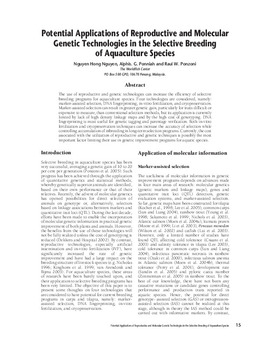Potential applications of reproductive and molecular genetic technologies in the selective breeding of aquaculture species

Citation
Nguyen, N.H.; Ponniah, A.G.; Ponzoni, R.W. (2006). Potential applications of reproductive and molecular genetic technologies in the selective breeding of aquaculture species. p. 15-21. In: Ponzoni, R.W. ; Acosta, B.O. ; Ponniah, A.G. (eds.) Development of aquatic animal genetic improvement and dissemination programs: current status and action plans. WorldFish Center Conference Proceedings 73. Penang, Malaysia. 120 p.
The use of reproductive and genetic technologies can increase the efficiency of selective breeding programs for aquaculture species. Four technologies are considered, namely: marker-assisted selection, DNA fingerprinting, in-vitro fertilization, and cryopreservation. Marker-assisted selection can result in greater genetic gain, particularly for traits difficult or expensive to measure, than conventional selection methods, but its application is currently limited by lack of high density linkage maps and by the high cost of genotyping. DNA fingerprinting is most useful for genetic tagging and parentage verification. Both in-vitro fertilization and cryopreservation techniques can increase the accuracy of selection while controlling accumulation of inbreeding in long-term selection programs. Currently, the cost associated with the utilization of reproductive and genetic techniques is possibly the most important factor limiting their use in genetic improvement programs for aquatic species.
Permalink
Date Available
Type
Publisher
Copyright
CC BY 4.0
Research Themes
Topics
Language